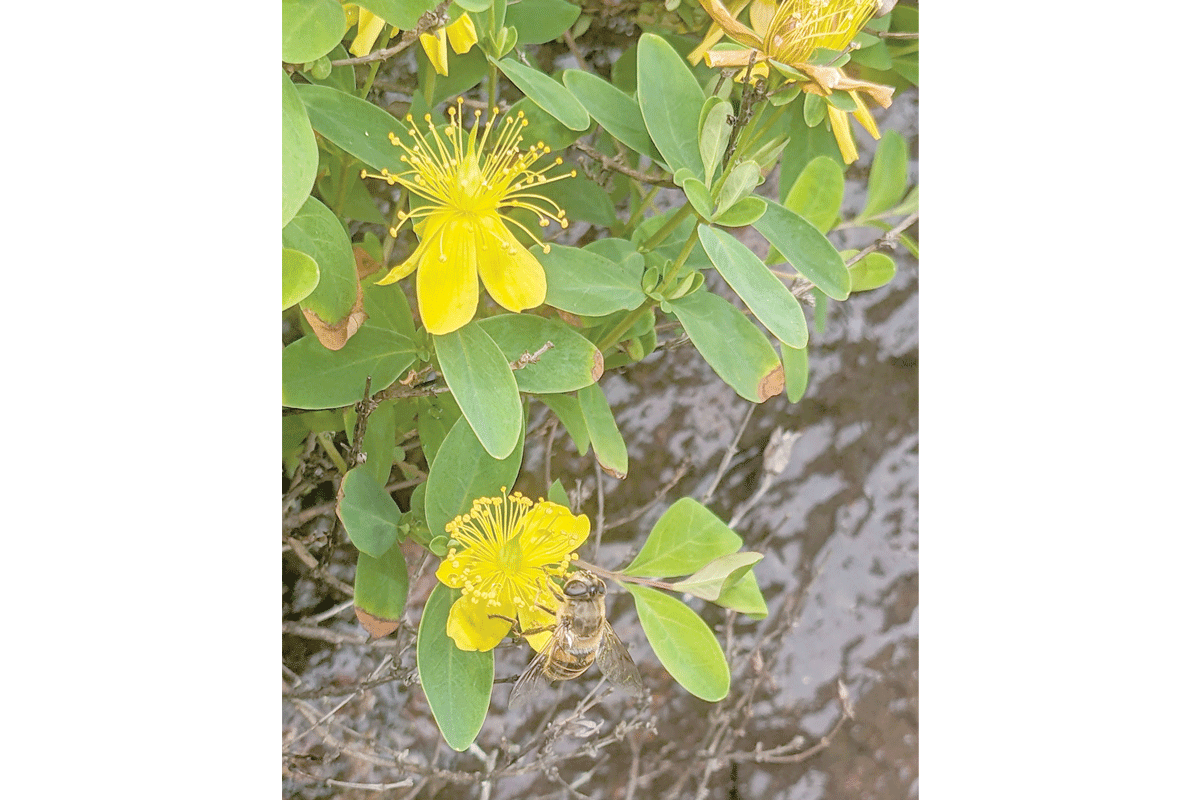Notes from a plant nerd: St. John’s wort
 There are numerous species of St. John’s wort, all with different sizes and growth habits but with similarities in identification and medicinal use. Adam Bigelow photo
There are numerous species of St. John’s wort, all with different sizes and growth habits but with similarities in identification and medicinal use. Adam Bigelow photo
Among the many plants that signify the start of summer, perhaps none is more showy than St. John’s wort (Hypericum spp.)
From its soft, rounded, blueish-green leaves to the vividly striking yellow of the flower petals, to the often numerous and showy stamens, St. John’s wort brings a smile to my face every time I see it in flower.
There are numerous species of St. John’s wort that grow in the mountains around us. Some are herbaceous plants, dying back to the ground and regrowing from the roots each year. Others are deciduous woody species, whose stems remain above ground through the winter, regrowing leaves each spring from those above ground stems. Some species are large plants with big yellow flowers, while others are so small that it takes a keen eye to even notice the plants, and a magnifying glass or macro lens to see the flowers.
But no matter the size and growth habit of the species, St. John’s wort plants all share a few characteristics that can help you in their identification. The flower petals are all yellow, with color ranging from a pale, lemony yellow to a deeply orange hue depending on the species. Leaves of St. John’s wort are arranged oppositely along the stem, meaning that wherever one leaf emerges from the stem, there will be another leaf growing on the other side of the stem. The leaves themselves have a rounded tip and have a “soft” look to them, that I can’t really describe other than saying that they look soft.
Among my favorites of this species are the woody shrub forms of this plant. The shrubby St. John’s Wort (Hypericum prolificum) has a beautiful, mounded growth habit with numerous leaves and showy large yellow flowers with only a few blooms growing at the end of the stem. The prolific growth of the leaves on this shrub provides the second part of the Latin name “prolificum.” The bushy St. John’s wort (Hypericum densiflorum) has leaves that are narrower than its shrubby relative, with smaller and more numerous flowers both at the end of the branch, and in the middle where the leaves attach to the stem, giving it a fuller and more dense overall blooming. Hence the name “densiflorum.”
The name St. John’s wort derives from the peak of this plant’s blooming in the northern hemisphere, which corresponds to the celebration of John the Baptist in the Catholic church on St. John’s Day, which is June 24th. The genus name of Hypericum derives from this plant’s use in summer celebrations that predate Christianity in Europe. Flowers of St. John’s wort resemble the sun and were hung over top of religious icons in altars to celebrate the height of summer. The prefix “hyper” means above and suffix “-icum” refers to icons. Hence, hypericum means above the icon.
Related Items
Herbaceous species of St. John’s wort, meaning those species that die back to the ground every year for the winter and regrow in the spring, are known for their use in herbalism to effectively treat and prevent depression and anxiety. There is a medicinal species that is native to Europe, Hypericum perfoliatum, that was introduced to North America and has become an invasive species. One great way to control its spread is to harvest it and use it to prepare medicine. It is identifiable by taking a leaf and holding it up to light, where you will see tiny, clear holes in the leaf where light shines through giving the leaf a “perforated” look like a sheet of notebook paper that is easily torn.
A similarly medicinal, yet native species is the spotted St. John’s wort (Hypericum punctatum) so named because when you hold its leaves up to the sun and look at the underside of the leaf, you will see little black spots or dots on the leaf. Punctate is a botanical word that means spotted. The way I remember that is thinking about punctuation, and how the period at the end of a sentence is a little black dot.
In no way do I mean to make light of the serious disease of depression, nor the great benefit that many people receive from taking St. John’s wort to relieve the symptoms. But no matter what is going on in my life, every time I see the beautiful flowers of St. John’s wort blooming, I immediately feel better, and a smile grows on my face. Give yourself some sunshine and plant some St. John’s wort in your landscape. It might help you feel better, too.
(Adam Bigelow lives in Cullowhee and leads weekly wildflower walks most Fridays and offers consultations and private group tours through Bigelow’s Botanical Excursions. This email address is being protected from spambots. You need JavaScript enabled to view it..)









